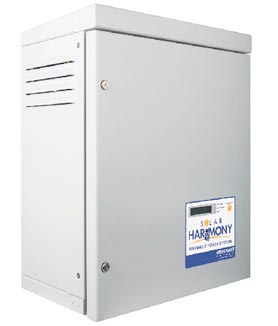
Solar Harmony Thin Film Panels

The only product of its kind, GeoSmart’s Solar Harmony Thin Film Panels offer a superior alternative to traditional mono-crystalline solar panels generating a 10-20% higher energy yield.
These attractive photovoltaic (PV) panels flush mount to the roof, maximize available roof space and generate increased energy output even under partially-shaded conditions thanks to their cutting edge massive parallel configuration. The end result is a reduction in material costs and installation time, and most importantly, an increased return on investment.
Solar Harmony Inverter

GeoSmart’s Solar Harmony Inverter maximizes the energy output from our Solar Harmony Thin Film Panels using ultra low voltage inverter technology.
Setting a new benchmark for system safety, the inverter eliminates high DC voltage hazards often associated with photovoltaic (PV) systems and safely converts the energy to AC.
The flexible design of our Solar Harmony Inverter makes it compatible with all solar module technologies including thin film, crystalline and concentrated PV.
How Solar Works
The sun is a clean, free, environmentally friendly energy source that has the capacity to generate heat, electricity, lighting and mechanical power for your home or business.
Solar energy technology harnesses the power of the sun by converting sunlight into electricity using photovoltaic (PV) solar cells. Made of layers of crystalline silicon, PV cells act as semi-conductors absorbing energy from the sun’s rays to generate an electrical current.
To maximize energy output, PV solar cells are grouped together in thin solar panels. Given their increased sensitivity to light, thin solar panels are able to generate 10-20% higher energy yield than traditional mono-crystalline solar panels. When thin solar panels are wired massively in a parallel configuration on a rooftop, they make the roof a virtual power plant.
To make this electricity usable, it must feed into a solar inverter that converts it into an alternating current (AC). This is the type of electricity used to power home appliances. It also the type of electricity used by community power grids. The parallel configuration of the solar panels allows for high efficiency at ultra low operating voltages, boosting system safety.
Excess energy produced by residential solar energy systems, where allowed by law, can feed into the community power grid, where it can be used to provide electricity to the community, particularly during peak power periods.
